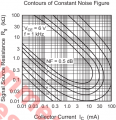I came across this phono preamp which takes in small (~5mv) audio frequency signal from a turntable and amplifies it by ~38db.
The first stage transistor (TR1) is running at a very low Vce (1.5v or less). This places the Q point at the very fringe end of the vce-ice/ib curve almost near the knee of the curve. I believe this is not a very linear point of operation. My goal is to increase the Q point of this transistor just a little bit up to about 3v without altering the load impedances and gain in a big way.
Do note that the small RC network by itself at the bottom of the circuit is the riaa equalization network which is needed for a flat frequency response in a phono preamp. R13 also serves as some kind of feedback.
Would love to get the experts ideas and thoughts on this.
Thanks!
The first stage transistor (TR1) is running at a very low Vce (1.5v or less). This places the Q point at the very fringe end of the vce-ice/ib curve almost near the knee of the curve. I believe this is not a very linear point of operation. My goal is to increase the Q point of this transistor just a little bit up to about 3v without altering the load impedances and gain in a big way.
Do note that the small RC network by itself at the bottom of the circuit is the riaa equalization network which is needed for a flat frequency response in a phono preamp. R13 also serves as some kind of feedback.
Would love to get the experts ideas and thoughts on this.
Thanks!
Attachments
-
536.1 KB Views: 39













